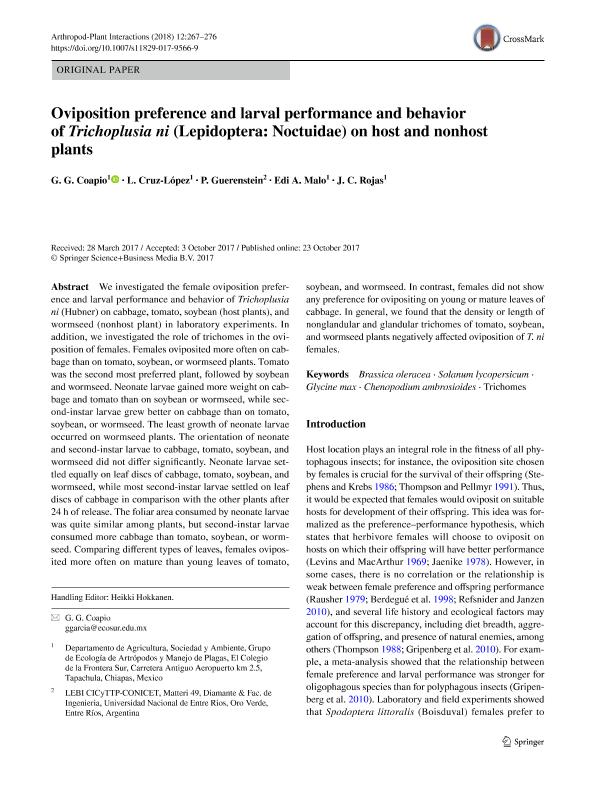Mostrar el registro sencillo del ítem
dc.contributor.author
Coapio, G. G.
dc.contributor.author
Cruz López, L.
dc.contributor.author
Guerenstein, Pablo Gustavo

dc.contributor.author
Malo, Edi A.
dc.contributor.author
Rojas, J. C.
dc.date.available
2019-07-23T21:52:52Z
dc.date.issued
2018-04
dc.identifier.citation
Coapio, G. G.; Cruz López, L.; Guerenstein, Pablo Gustavo; Malo, Edi A.; Rojas, J. C.; Oviposition preference and larval performance and behavior of Trichoplusia ni (Lepidoptera: Noctuidae) on host and nonhost plants; Springer; Arthropod-plant Interactions; 12; 2; 4-2018; 267-276
dc.identifier.issn
1872-8855
dc.identifier.uri
http://hdl.handle.net/11336/80103
dc.description.abstract
We investigated the female oviposition preference and larval performance and behavior of Trichoplusia ni (Hubner) on cabbage, tomato, soybean (host plants), and wormseed (nonhost plant) in laboratory experiments. In addition, we investigated the role of trichomes in the oviposition of females. Females oviposited more often on cabbage than on tomato, soybean, or wormseed plants. Tomato was the second most preferred plant, followed by soybean and wormseed. Neonate larvae gained more weight on cabbage and tomato than on soybean or wormseed, while second-instar larvae grew better on cabbage than on tomato, soybean, or wormseed. The least growth of neonate larvae occurred on wormseed plants. The orientation of neonate and second-instar larvae to cabbage, tomato, soybean, and wormseed did not differ significantly. Neonate larvae settled equally on leaf discs of cabbage, tomato, soybean, and wormseed, while most second-instar larvae settled on leaf discs of cabbage in comparison with the other plants after 24 h of release. The foliar area consumed by neonate larvae was quite similar among plants, but second-instar larvae consumed more cabbage than tomato, soybean, or wormseed. Comparing different types of leaves, females oviposited more often on mature than young leaves of tomato, soybean, and wormseed. In contrast, females did not show any preference for ovipositing on young or mature leaves of cabbage. In general, we found that the density or length of nonglandular and glandular trichomes of tomato, soybean, and wormseed plants negatively affected oviposition of T. ni females.
dc.format
application/pdf
dc.language.iso
eng
dc.publisher
Springer

dc.rights
info:eu-repo/semantics/openAccess
dc.rights.uri
https://creativecommons.org/licenses/by-nc-sa/2.5/ar/
dc.subject
Brassica Oleracea
dc.subject
Chenopodium Ambrosioides
dc.subject
Glycine Max
dc.subject
Solanum Lycopersicum
dc.subject
Trichomes
dc.subject.classification
Zoología, Ornitología, Entomología, Etología

dc.subject.classification
Ciencias Biológicas

dc.subject.classification
CIENCIAS NATURALES Y EXACTAS

dc.title
Oviposition preference and larval performance and behavior of Trichoplusia ni (Lepidoptera: Noctuidae) on host and nonhost plants
dc.type
info:eu-repo/semantics/article
dc.type
info:ar-repo/semantics/artículo
dc.type
info:eu-repo/semantics/publishedVersion
dc.date.updated
2019-07-23T13:00:09Z
dc.journal.volume
12
dc.journal.number
2
dc.journal.pagination
267-276
dc.journal.pais
Alemania

dc.journal.ciudad
Berlin
dc.description.fil
Fil: Coapio, G. G.. El Colegio de la Frontera Sur; México
dc.description.fil
Fil: Cruz López, L.. El Colegio de la Frontera Sur; México
dc.description.fil
Fil: Guerenstein, Pablo Gustavo. Provincia de Entre Ríos. Centro de Investigaciones Científicas y Transferencia de Tecnología a la Producción. Universidad Autónoma de Entre Ríos. Centro de Investigaciones Científicas y Transferencia de Tecnología a la Producción. Consejo Nacional de Investigaciones Científicas y Técnicas. Centro Científico Tecnológico Conicet - Santa Fe. Centro de Investigaciones Científicas y Transferencia de Tecnología a la Producción; Argentina
dc.description.fil
Fil: Malo, Edi A.. El Colegio de la Frontera Sur; México
dc.description.fil
Fil: Rojas, J. C.. El Colegio de la Frontera Sur; México
dc.journal.title
Arthropod-plant Interactions

dc.relation.alternativeid
info:eu-repo/semantics/altIdentifier/url/https://link.springer.com/article/10.1007/s11829-017-9566-9
dc.relation.alternativeid
info:eu-repo/semantics/altIdentifier/doi/https://doi.org/10.1007/s11829-017-9566-9
Archivos asociados
